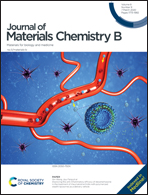A sustained zero-order release carrier for long-acting, peakless basal insulin therapy†
Abstract
Basal insulin therapy plays a key role in diabetes management. An ideal therapy should mimic the steady physiologic basal insulin secretion, and provide a peak-free, prolonged and steady insulin supply. Herein, a new drug carrier was designed by first PEGylating insulin and then incorporating the conjugate into layer-by-layer assembled films with tannic acid (TA). Because PEG-insulin and TA in the films were linked with reversible, dynamic hydrogen bonds, the films disintegrate gradually when soaked in aqueous solutions, and thus release PEG-insulin into the media. In vitro release tests revealed that the release of PEG-insulin follows a zero-order kinetics. Theoretical analysis based on the unique release mechanism also supports a zero-order kinetics. In vivo tests using a streptozotocin-induced diabetic rat model demonstrated that subcutaneous implantation of the film could maintain a steady plasma drug level and hence maintain a fasting blood glucose level (BGL) close to normal. The duration of action depends on the thickness of the film. Using a 50-bilayer film, fasting BGL was kept within the normoglycemic range for ∼16 days. Initial burst release, a severe problem for other release systems, was successfully avoided.



 Please wait while we load your content...
Please wait while we load your content...